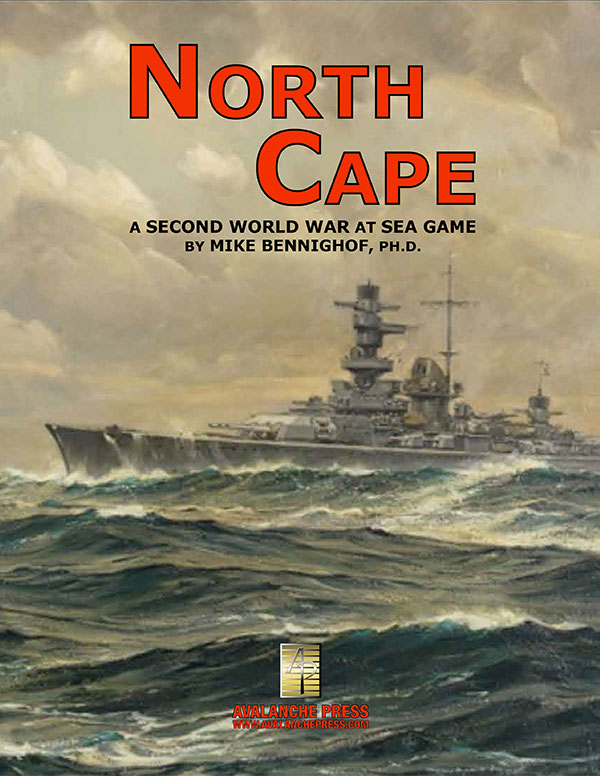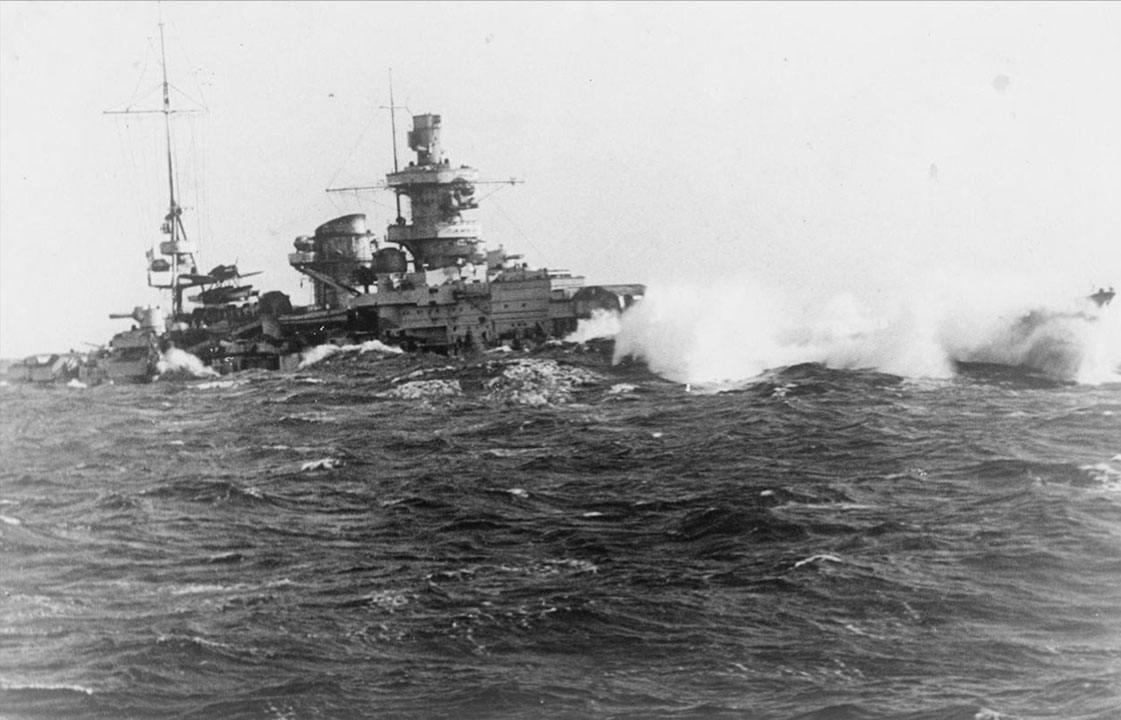| North Cape, Chapter Five:
The Kriegsmarine’s Last Call
By Mike Bennighof, Ph.D.
February 2025
 Once the United States entered the Second World War in earnest, it didn’t take long for the momentum to shift in favor of the Allies. It took a while for American industrial might to translate itself into military power (both for her own forces, and those of her allies), but once it did, the fascist cause was on a fast track to doom. Once the United States entered the Second World War in earnest, it didn’t take long for the momentum to shift in favor of the Allies. It took a while for American industrial might to translate itself into military power (both for her own forces, and those of her allies), but once it did, the fascist cause was on a fast track to doom.
That shift’s reflected in Second World War at Sea: North Cape. North Cape is unusual in the Second World War at Sea lineup, as its scenario set extends over a very long stretch of time and covers multiple phases of what’s usually seen historically as one long, grinding campaign.
The height of the action took place throughout 1942, as the Western Allies sought to prop up a Soviet Union reeling under the blows of the German summer offensive. Recognizing this, the Germans in turn deployed ships and aircraft to interfere with the convoy traffic. They did that with some success, but only managed to constrict the flow of weapons and materials, not completely shut it down. Merchant crews of many nations steamed through the gauntlet in incredible acts of selfless, thankless, and now mostly forgotten bravery.
North Cape’s set of 52 scenarios is divided into six chapters, each of them focused on one segment of this long war. Chapter Five is one of the shorter chapters, with six scenarios: three operational scenarios (that take place on the big map of the Arctic, where task forces move and seek one another), and three battle scenarios (where battle is resolved on the Tactical Map, where ships move and shoot at each other with guns and torpedoes). Yet despite the small scenario count (small by our standards; that’s a lot of scenarios for some wargames) is more than balanced by their weight: these scenarios include a high ratio of battleship action.

The Battle of the Barents Sea (the last scenarios of Chapter Three) cost German Navy commander Erich Raeder his job. The new commander, Karl Dönitz, had been head of the submarine branch and hoped to unleash his u-boats against the convoys bringing American troops to Britain along with weapons, supplies and food for the civilian population. And though the strategic shift reflected Dönitz’s preferences (and those of Adolf Hitler, who had been enraged by the failure of his surface fleet in the Battle of the Barents Sea), the North Atlantic had become a target-rich environment.
Britain, in the view of the Western Allies, had to be succored even at the cost of aid to the Soviet Union. This had a practical side, as convoys to Murmansk had to stage through Britain, and a political one, as the Western democracies would look after their own first. For most of 1943, the Western Allies shut down the convoy traffic through the Arctic while they deployed their escorts to battle German submarine wolfpacks in the North Atlantic.

Scharnhorst in heavy seas.
It would be the Germans who broke the lull. They had deployed meteorological teams to the Norwegian-ruled Svalbard Archipelago, to monitor weather headed from the Arctic down toward Europe and the North Atlantic. In the days before satellites, such information could prove crucial for planning air and naval operations. The small Norwegian garrison had realized they had uninvited visitors and started hunting them down. This enraged Adolf Hitler, who demanded retribution.
Given the chance to actually use their fleet again, the German naval staff laid on the largest operation they would take outside of coastal waters for the entire war. Both of their operational battleships would headline the invasion, along with nine destroyers. Together they carried a battalion of infantry to Svalbard, where the Germans vandalized the tiny capital Longyearbyen and set a coal mine on fire. Then they went home.
British attempts to intercept them started out too late and failed to make contact; but this would have resulted in a clash between two British fast battleships (Duke of York and Anson) against two Germans ones (Tirpitz and Scharnhorst). And that would have taken place far beyond the range of aircraft, making for a gunnery duel that we can play out on the game table, with the British battleships finally having their 14-inch main batteries fully capable of showing their fine qualities.
Once again, as we saw in the last installment of this preview, the Germans had managed to risk valuable assets for essentially no gain. Punishing the tiny Norwegian garrison did not make it easier to obtain weather data. The operation appears to have been undertaken because the German fleet had nothing better to do, and once they returned to Norway, they resumed doing nothing.

Survivors of Scharnhorst, aboard HMS Duke of York.
Next it would be the Allies who broke the quiet. The suspension of convoy traffic left the ships that had carried goods to Murmansk and Arkhangel’sk awaiting a chance to return, and in November 1943 they finally set sail for Britain. The Germans reacted with surprising aggression, sending out Scharnhorst, the jinx ship Lützow and five destroyers in search of a dozen empty merchant ships and one carrying lumber. The fuel expended alone probably wouldn’t have justified sinking all of the merchants, but in the actual event the Germans never located the convoy in thick fog.
The takeaway in Adolf Hitler’s bunker, though, was that Scharnhorst had set out in pursuit of an Allied convoy and returned safely. And so, the greatest commander of all times granted permission to use her again, against the next Allied convoy. That chance came in late December, and Scharnhorst sortied despite the local commander’s preference to undertake the mission only with destroyers. Dönitz overruled him; if they showed the great leader that the heavy ships were not necessary for success, Hitler might well order them scrapped. The British were ready, the British sank her (in the titular Battle of the North Cape), and with Tirpitz still under repair following a mini-submarine attack in September 1943, German major surface operations in the Arctic were at an end.
The Battle of the North Cape alone could probably have been built up into a stand-alone game, but that’s not how we do things. You don’t have to play all 52 scenarios to enjoy yourself. But you could. The idea here is to tell the full story, and you can participate in it as much as you choose. You’re going to want to play it a lot.
You can order North Cape right here.
Sign up for our newsletter right here. Your info will never be sold or transferred; we'll just use it to update you on new games and new offers.
Mike Bennighof is president of Avalanche Press and holds a doctorate in history from Emory University. A Fulbright Scholar and NASA Journalist in Space finalist, he has published a great many books, games and articles on historical subjects; people are saying that some of them are actually good.
He lives in Birmingham, Alabama with his wife and three children. He misses his lizard-hunting Iron Dog, Leopold.
Daily Content includes no AI-generated content or third-party ads. We work hard to keep it that way, and that’s a lot of work. You can help us keep things that way with your gift through this link right here.
|
